April 14, 2025 | 01:24 GMT +7
April 14, 2025 | 01:24 GMT +7
Hotline: 0913.378.918
April 14, 2025 | 01:24 GMT +7
Hotline: 0913.378.918
In August, the United States formally opened its market to Vietnamese exports of fresh coconut. Currently, coconut farmers and businesses are eager to increase output to meet market demand, particularly for exports to the United States.
According to Mr. Bui Duong Thuat, Director of Mekong Fruit Export Ltd.Co in Chau Thanh District, Ben Tre Province, the US market is only second in size to the Chinese market. Annually, the United States imports approximately 2,000 containers of raw coconut from other countries.

Vietnamese fresh coconuts are facing a great opportunity when they are opened to the US market as well as have the prospect of exporting to the Chinese market. Photo: Minh Dam.
Nonetheless, Vietnamese businesses have exported between 110 and 120 containers of fresh coconuts to this nation. It implies that there is a substantial unfulfilled market opportunity for Vietnamese coconut in the United States. Following in the footsteps of the United States, the General Administration of Customs of China is inspecting cultivation areas in order to endorse a protocol authorizing the official importation of Vietnamese fresh coconut to this billion-person market.
Thuat anticipates that Vietnamese fresh coconut will be exported to China as soon as possible. To take advantage of this opportunity to export fresh coconut to this large market, Thuat believed that it was necessary to overcome current obstacles and limitations, such as standard material concentration areas, the reduction of production costs to increase competitiveness, and the strengthening of ties between "4 ers" including the state, farmers, producers, and scientists.
Mekong Fruit Import-Export Limited Company intended to establish a 100-hectare organic raw material area in Ben Tre in collaboration with local coconut farmers to seize the opportunity.
Government agencies, local authorities, and organizations are actively assisting coconut producers in meeting the standards necessary to access the U.S. and Chinese markets so as not miss this valuable opportunity.
Mr. Vo Van Hai, the Chairman of the Commune Farmers' Association in Giong Trom district, Ben Tre province, and an experienced local farmer, was introduced. Luong Hoa is one of the most productive coconut-growing regions in Vietnam. Currently, there are more than 716 hectares of coconut plantations in the commune, with 300 hectares dedicated to drinking coconuts.
Mr. Vo Van Hai explained that in this soil, drinking coconuts prosper. Historically, the region mainly cultivated citrus fruits and green-skinned pomelos, but salinity issues altered the agricultural landscape, resulting in an increase in the cultivation of coconuts, particularly drinking coconuts. Local producers focus on cultivating the Ben Tre-exclusive green coconut variety.
Coconut producers in Ben Tre plant each tree approximately 6 meters apart. On every 1,000 square meters of land, they can establish between 18 and 20 coconut trees. In comparison to desiccated coconuts, drinking coconuts are harvested every 20 to 25 days, resulting in 14 to 15 harvests per year. Each green-skinned coconut tree can produce twenty to thirty coconuts per harvest. Nevertheless, for approximately two months each year (March and April), during the "hanging coconut" season, each coconut tree produces only 10 to 12 crops per harvest. On average, each sipping coconut tree yields between 140 and 150 coconuts per year and can generate up to 100 million VND per hectare.
When people think of Ben Tre, they naturally think of the country's coconut capital. Approximately 40% of the national coconut cultivation area and 46% of the Mekong Delta region are currently occupied by the province. Mr. Huynh Quang Duc, Deputy Director of the Provincial Department of Agriculture and Rural Development, disclosed that the province has over 78,000 hectares of coconut plantations and annually produces over 800 million coconuts. This is dispersed throughout nine districts and the city.
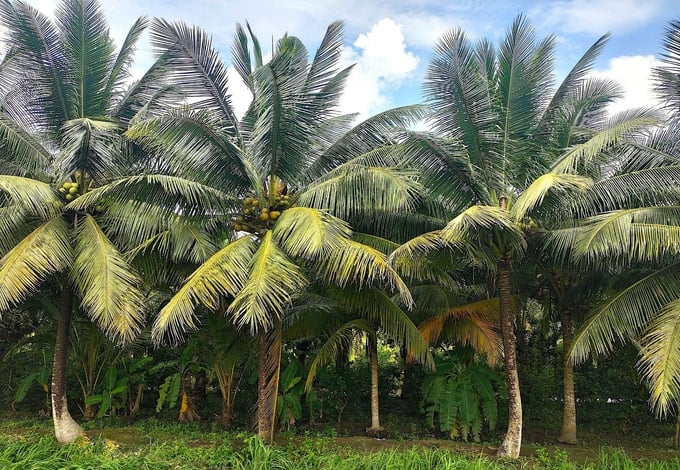
Ben Tre has the largest coconut area in the country with nearly 16,000 hectares. Photo: Minh Dam.
Regarding coconut water, the province cultivates nearly 16,000 hectares (20% of the total area) of coconuts. Approximately 390 million coconuts are produced annually in the consuming coconut region, forming a reliable supply chain for both the domestic and export markets. About fifty percent of the coconuts meet export requirements. Ben Tre offers a variety of drinking coconut varieties, such as green-skinned coconuts, green-skinned coconuts with a slightly reddish tint, and strawberry coconuts, which are prized for their delicious water quality (with a sugar content of 7-9%), making them highly desirable on the market.
Ben Tre has more than five enterprises that export fresh coconuts to Japan, Singapore, Taiwan, Australia, Canada, etc. There are currently twenty companies engaged in the construction of export packaging facilities and region codes for the Chinese market. This includes thirteen packaging facilities and thirty-five cultivation regions covering a total of 2,343 hectares that have submitted their documents to the Plant Protection Department in preparation for supplying the Chinese market.
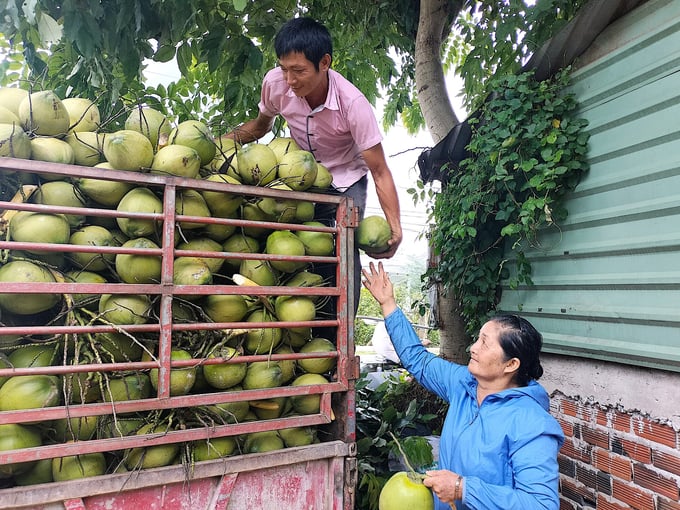
Traders buying Ben Tre coconut. Photo: Minh Dam.
According to the Ben Tre Department of Industry and Trade, coconut fiber is processed into various forms for both domestic and international consumption, including diamond-cut coconuts, stripped coconuts, and canned coconuts. Ben Tre's green-skinned coconuts have distinct morphological characteristics that make them easily identifiable: they are tiny, have green outer shells, and contain sweeter water than green-skinned coconuts grown in other regions. Ben Tre's green-skinned coconuts are gaining popularity due to their high nutritional value and health benefits.
The analysis reveals that Ben Tre's green-skinned coconut water contains approximately 3.18 milligrams of vitamin C per liter. Multiple factor correlations reveal a positive relationship between vitamin C content, pH levels, and the soil's absorption-friendly phosphorus content.
Ben Tre's green coconut water contains approximately 7.36% brix. Brix level has a moderately positive correlation with soil phosphorus and potassium exchange that is readily available for absorption. Ben Tre's green-skinned coconut water contains approximately 4.63g of sugar per 100 ml. The average zinc concentration in coconut-growing soil in Ben Tre is 7.83 ppm, and the correlation between reducing sugar content and zinc levels in the soil is suggested by the analysis results.
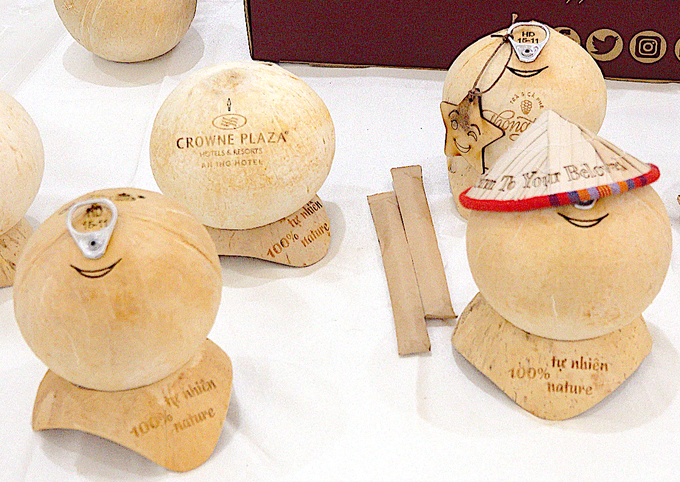
Freshly peeled coconut products. Photo: Minh Dam.
In addition to extremely favorable natural conditions for the development of green-skinned coconut palms, the farming practices of Ben Tre's coconut farmers contribute to the distinctive qualities of their green-skinned coconuts. Local farmers maintain well-drained soil by dredging canals and adding sediment each year.
The combination of these traditional agricultural practices with the application of scientifically informed techniques promotes the healthy growth of coconut trees, high yields, and high-quality production. Farmers in Ben Tre use technical solutions such as canal dredging and elevated coconut planting to help coconut trees adapt to the local environment, assuring optimal conditions for coconut growth, irrigation, and harvesting.
People can collect settled mud and organic matter from the river silt in canals to enrich the soil for flourishing coconut trees, thanks to the canal system and tidal regime of the local coconut land. In addition to storing fresh water during the rainy season, the canal system provides supplemental irrigation for coconuts during dry periods. All of these factors have contributed to Ben Tre's green coconuts' current reputation.
Translated by Linh Linh

(VAN) KOCHAM Deputy President expects that Vietnam would accelerate innovation and development of bird’s nest-based products as a representation of Vietnamese culture.
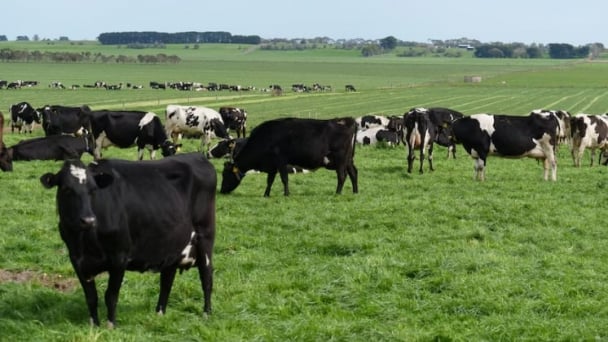
(VAN) Imported dairy products are weakening the local industry, according to dairy farmers and processors.
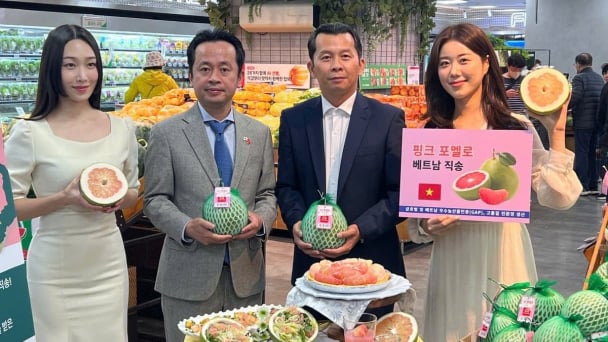
(VAN) April 10 marked a significant milestone for Vietnam's agricultural exports as Vietnamese pomelos officially became available at the Lotte Mart supermarket chain in South Korea.
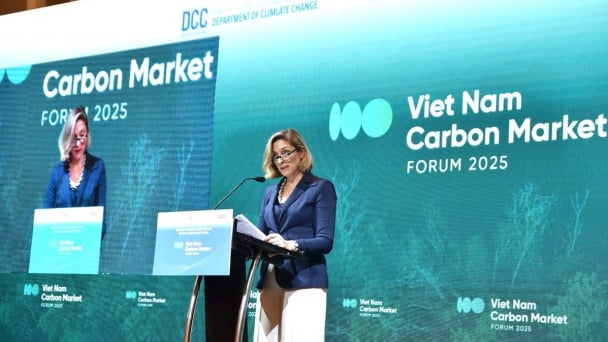
(VAN) Vietnam is focusing on developing the legal framework and technical infrastructure for the carbon market, with committed support from global financial institutions.
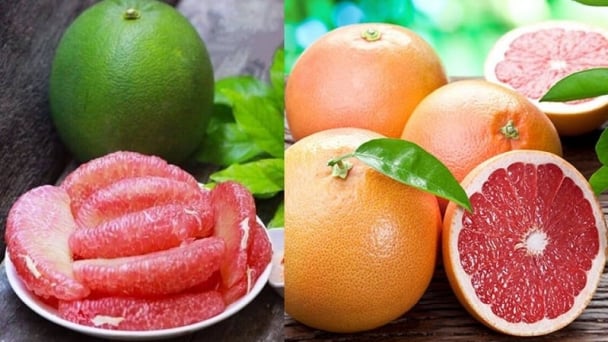
(VAN) The citrus fruits market in China is expected to slow down, but still show steady expansion, with volume reaching 56M tons and value reaching $71B by the end of 2035.
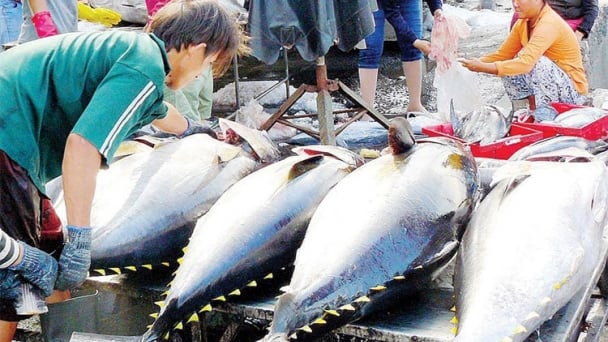
(VAN) The European Union issued a notice regarding the amendment of Annex III of Regulation (EC) No 853/2004 and aims to introduce new provisions in the fourth quarter of 2025.
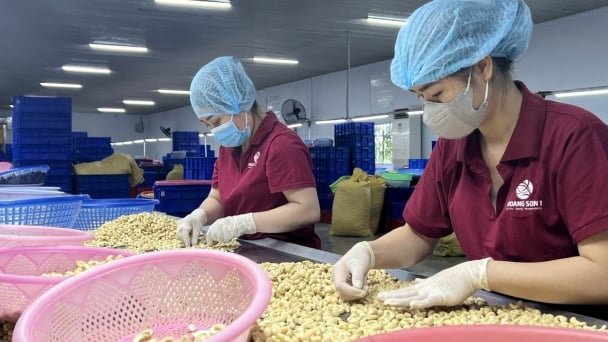
(VAN) Vietnam has great potential for exporting food to the global Halal market, but there is a need to build an ecosystem to develop this market.